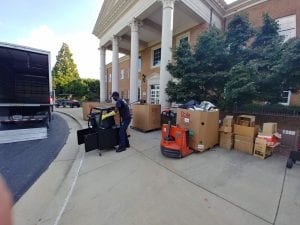As a school dedicated to innovation, Cary Academy utilizes a lot of technology on campus. Unfortunately, that also generates a considerable amount of potential e-waste.
As one of the world’s fastest-growing trash streams, e-waste has been identified as one of the most pressing environmental issues facing the global community.
“[E-waste] growth is staggering: The worldwide accumulation of e-waste has more than doubled in the last nine years. In 2016, according to the United Nations University, a global think tank that tracks the problem, the yearly accumulation reached 49.3 million tons — enough to fill more than a million 18-wheel trucks stretching from New York to Bangkok and back. By 2021, the annual total is predicted to surpass 57 million tons.
The explosion of e-waste highlights its dual (and dueling) identities as both environmental scourge and potential economic resource. Though often laced with lead, mercury or other toxic substances, laptops and phones also contain valuable elements like gold, silver and copper. Yet barely 20 percent of the world’s e-waste is collected and delivered to formal recyclers.” (New York Times, “E-Waste Offers an Economic Opportunity as Well as Toxicity.” July 5, 2018).
So, what is a school both deeply invested in technology and equally committed to environmental stewardship to do?
Right now, we employ two strategies: reuse and recycling.
Reuse. For equipment that is still usable, we try to donate or sell it. For example, we’ve donated some of our older Lenovo Yogas to Pencil’s for Hope and Holt Elementary Language Academy. Last year, 550 others were sold to community members and/or returned to Lenovo for reuse.
Recycle. For equipment that is no longer functional, we ensure that it is disposed of in an environmentally-safe manner. In September, GEEP (Global Electric Electronic Processing) picked up a staggering 5,765 pounds of hardware for recycling.
Curious about the process, our CA team tagged along to the GEEP facility to learn more.
Once items arrive at GEEP’s secure location, all items are weighed and tagged for entry into their electronics tracking system. Equipment is then sorted by type and vetted for any non-recyclable or hazardous components. Proprietary machinery breaks up the electronics and processes them into base commodities, which are sold to be refined and made into new products. A Certificate of Destruction proves the complete and secure destruction of data-bearing devices.
Responsibly addressing e-waste is just one of the strategies that Cary Academy uses to help protect our environment.
Crayola Colorcycle
This year, we also launched Crayola Colorcycle on campus. Crayola ColorCycle repurposes used markers rather than sending them to landfills. To date, we’ve kept 338 markers (98 Sharpies, 20 Dry Erase, 153 Classic Crayola, 24 Crayola Skinny, and 43 generic plastic markers, to be exact) out of the landfill. We’re hoping to double that count next trimester.
Since launching in 2013, the Crayola program has repurposed more than 70 tons of expended markers and uses plastic conversion technologies to make wax compounds for asphalt and roofing shingles as well as to generate electricity that can be used to heat homes, cook food, and power vehicles.
Composting
Of course, CA has also been composting its food waste since 2014. This year, we’ve diverted over 46,116 pounds of waste from our local landfill, representing a greenhouse gas offset of 5,470 pounds of methane or 119,901 pounds of carbon dioxide. That’s the environmental impact equivalent of parking 445 cars for two weeks!
- .


